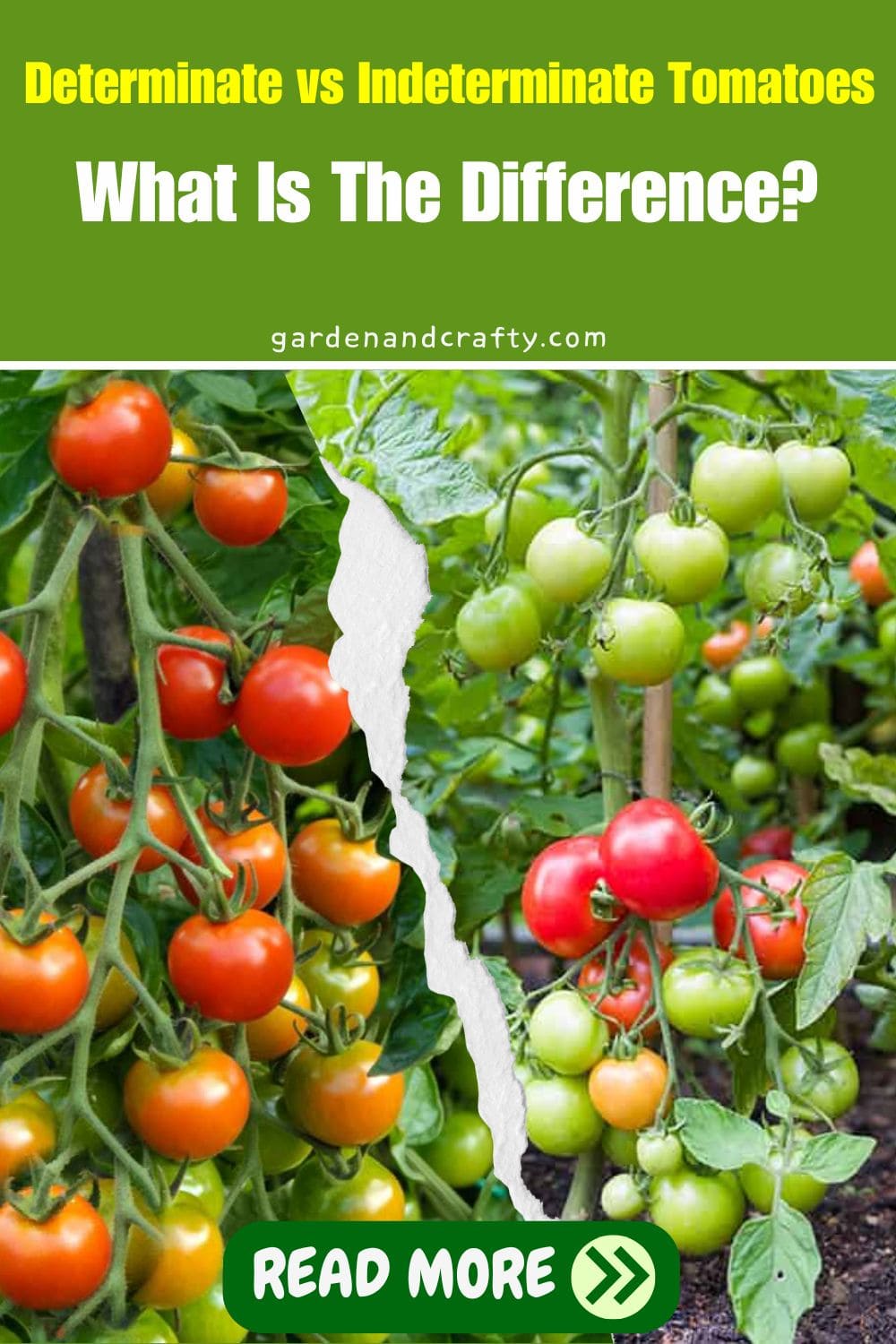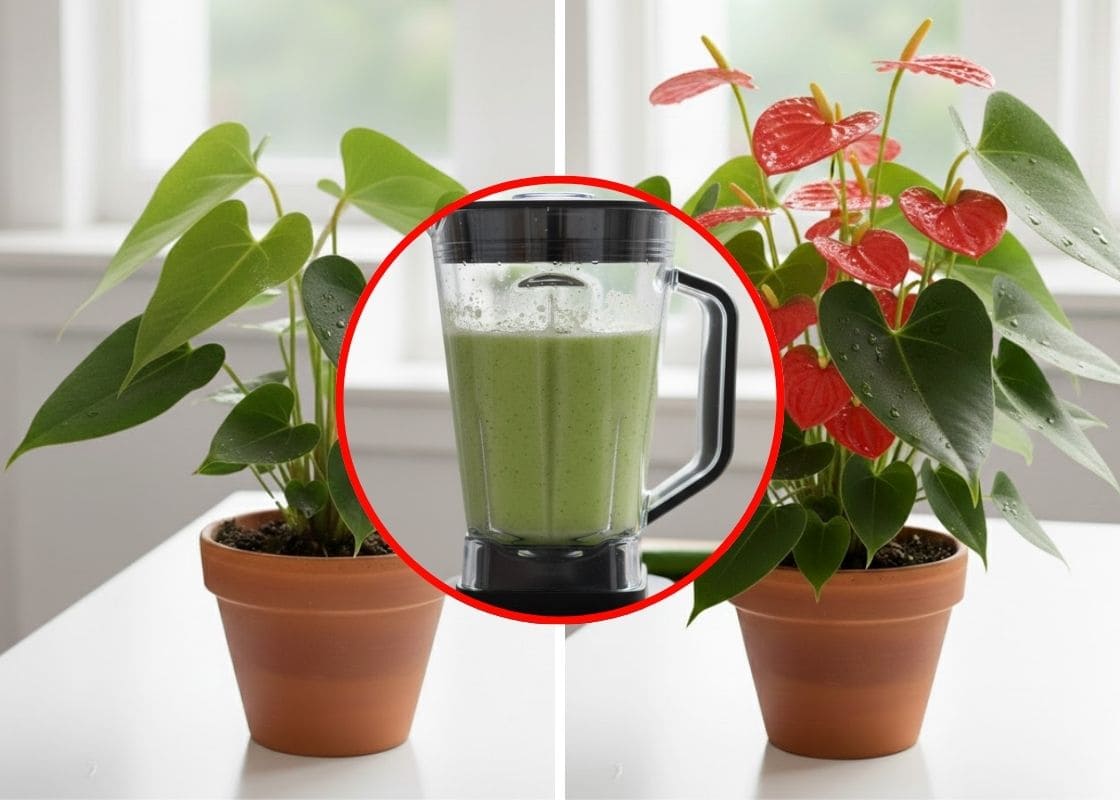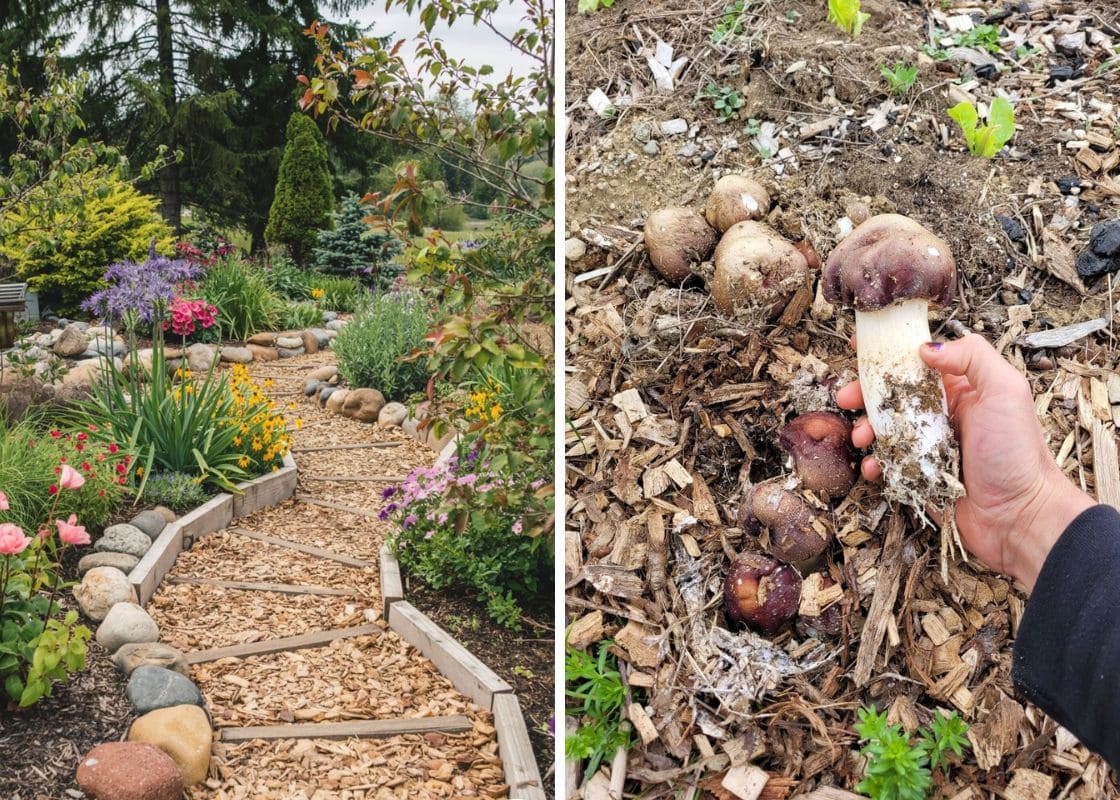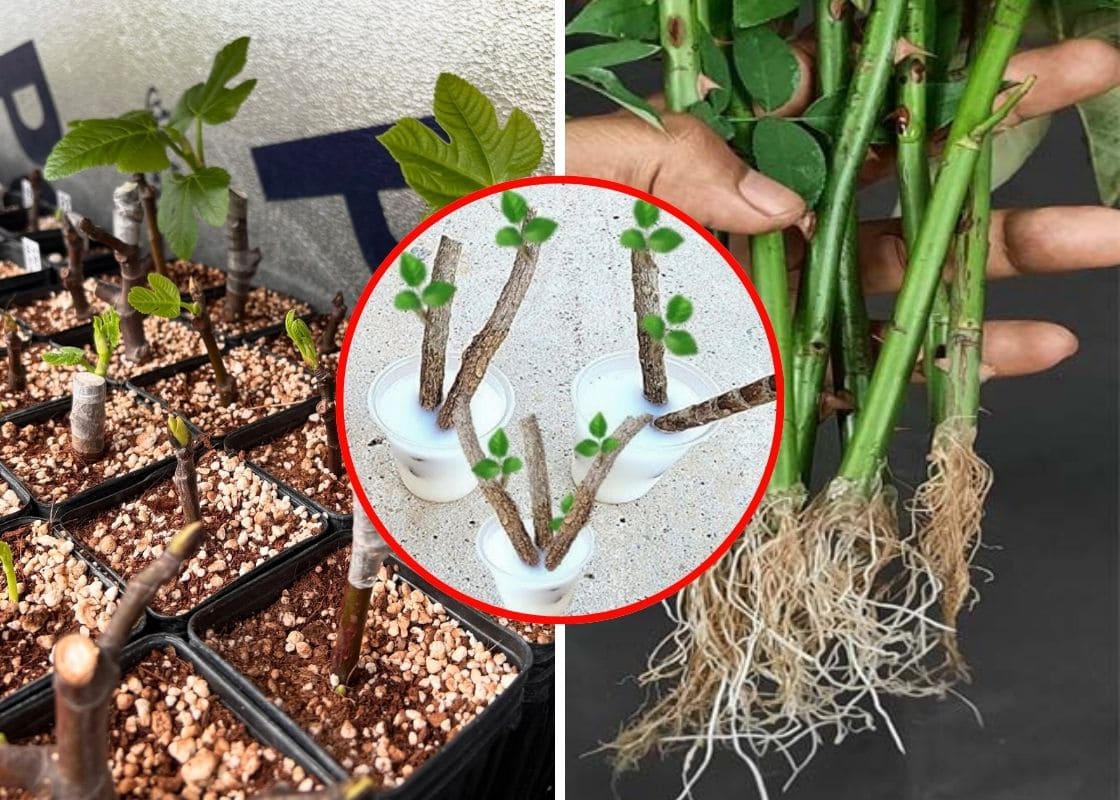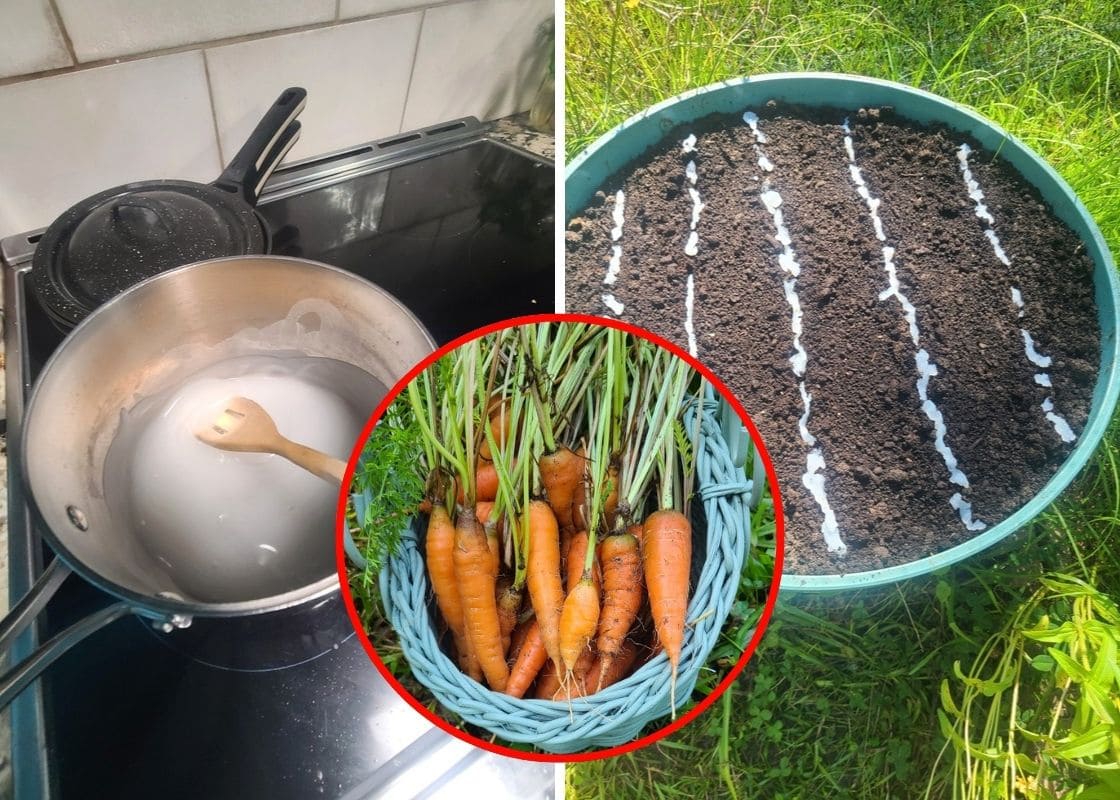When it comes to growing tomatoes, you might be wondering whether to choose determinate or indeterminate varieties. I’ve often found myself standing in the garden center, pondering this very question.
Determinate tomatoes, often called “bush tomatoes,” grow to a compact height and tend to ripen all their fruit within a short period. This makes them perfect for canning or making sauces.
On the other hand, indeterminate tomatoes, or “vining tomatoes,” continue to grow and produce fruit throughout the season, offering a steady supply for fresh salads and salsas.
Understanding the differences between these two types is crucial for planning your garden effectively and maximizing your harvest.
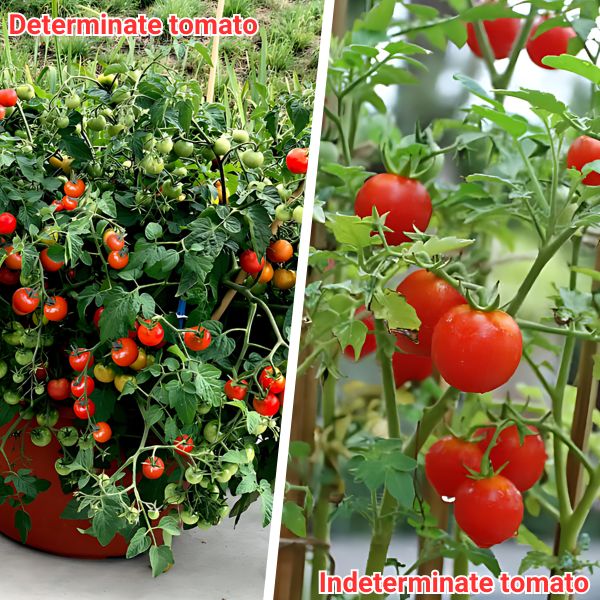
| Determinate Tomato | Indeterminate Tomato | |
| Lifecycle | Annual | Annual |
| Light | Full sun | Full sun |
| Climate | Warm | Warm |
| Soil | Well-drained | Well-drained |
| Growth Habit | Bushy | Vining |
| Maturity | Early to mid-season | Continuous throughout the season |
| Yield | High | Moderate to high |
| Support | None or minimal | Stake, Trellis, Cage |
| Harvest Period | Short and concentrated | Prolonged and continuous |
What Is Determinate And Indeterminate Tomato?
Determinate Tomato
Determinate tomatoes, often referred to as “bush tomatoes,” are a unique variety that I’ve enjoyed growing over the years. Unlike their vining counterparts, determinate tomato plants reach a certain height-typically around 3 to 4 feet-and then stop growing.
Scientifically, determinate tomatoes are characterized by a genetic trait that limits their vegetative growth, focusing energy on fruit production once a certain height is achieved. This makes them a favorite for those who prefer a manageable, high-yield garden.
Here are my favorite varieties of determinate tomato:
- Roma VF: Roma VF tomatoes have thick, meaty flesh with fewer seeds, they are ideal for sauces and pastes.
- Celebrity: Celebrity tomatoes offer a good balance of sweetness and acidity. This is a favorite among many gardeners.
- Patio Princess: Patio Princess tomatoes are compact and prolific, they are perfect for small spaces and container gardening.
- Rutgers: Rutgers tomatoes are known for their excellent flavor and firm texture, ideal for slicing and canning.
- Bush Early Girl: Fast-maturing, Bush Early Girl tomatoes produce ripe fruit in as little as 59 days.
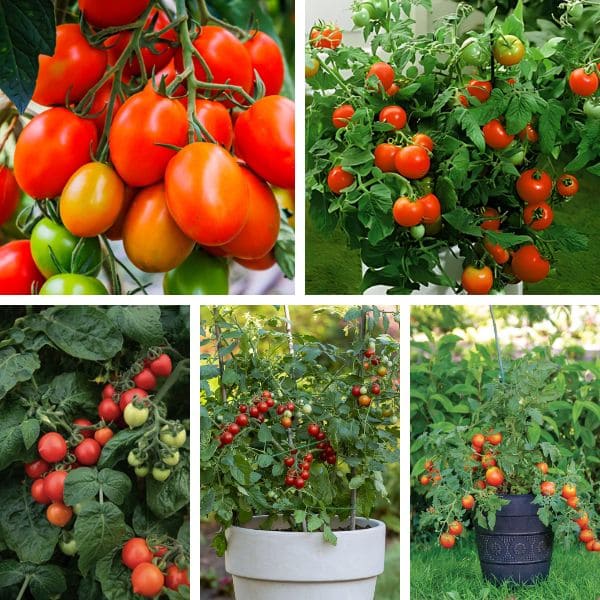
Indeterminate Tomato
Indeterminate tomatoes, often called “vining tomatoes,” are a gardener’s delight due to their continuous growth and fruit production throughout the season. Unlike determinate varieties, these plants keep growing taller and producing new fruit until frost or disease halts their progress.
Scientifically, this continuous growth habit is due to the plant’s ability to keep producing new flower clusters along its stem, rather than focusing on a single, finite harvest. This makes them ideal for those who enjoy fresh tomatoes all summer long.
Here are my favorite varieties of indeterminate tomato:
- Beefsteak: Beefsteak tomatoes are known for their large, meaty fruits, and are perfect for slicing and sandwiches.
- Cherry: These small, sweet tomatoes are ideal for snacking and salads, offering a burst of flavor in each bite.
- Brandywine: Brandywine tomato is a heirloom variety, cherished for their exceptional flavor and large, juicy fruits.
- Sungold: These cherry tomatoes are renowned for their sweet, tropical flavor and vibrant orange color.
- Black Krim: Black Krim tomatoes have a unique dark color and are great for fresh eating and cooking.
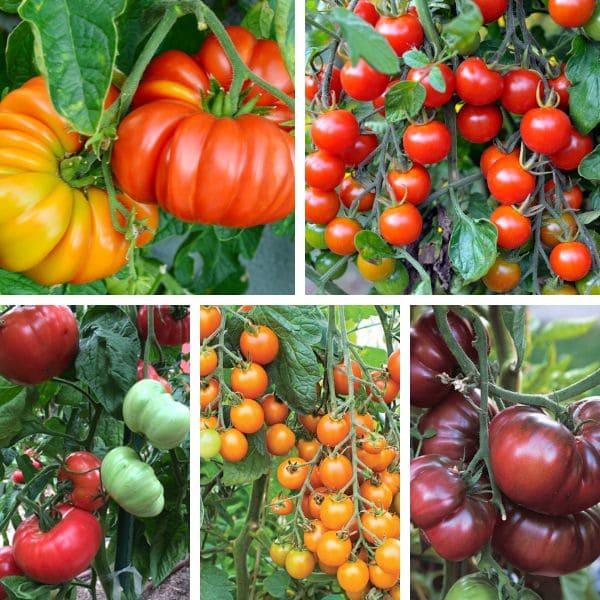
The Difference Between Determinate Vs Indeterminate Tomatoes
Growth Habit
Determinate tomatoes grow to a compact height, usually about 3 to 4 feet, and then stop. This makes them ideal for small spaces or container gardening.
In contrast, indeterminate tomatoes have incredible vining capability. These plants keep growing taller throughout the season, often reaching 8 to 10 feet by mid-summer when trellised.
I use a method called “lower and lean” to manage their growth, allowing them to continue producing fruit well into the fall. I’ve even seen indeterminate tomatoes grow over 20 feet long by the end of the season.
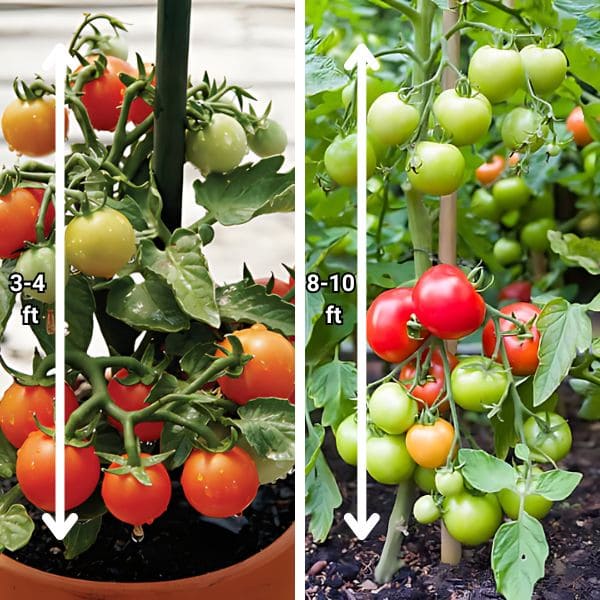
Fruit Production
Indeterminate tomatoes continuously produce new flowers and fruit as they grow, extending the harvest window throughout the entire season.
I love picking a handful of cherry tomatoes or a few big slicers every week for my salads and sandwiches. It’s a steady supply that keeps my kitchen stocked without overwhelming me all at once.
On the other hand, determinate tomatoes set all their fruit within a few weeks. Each healthy plant can yield around ten pounds of tomatoes in a short period. I find this extremely convenient for making large batches of salsa or tomato sauce to can or freeze.
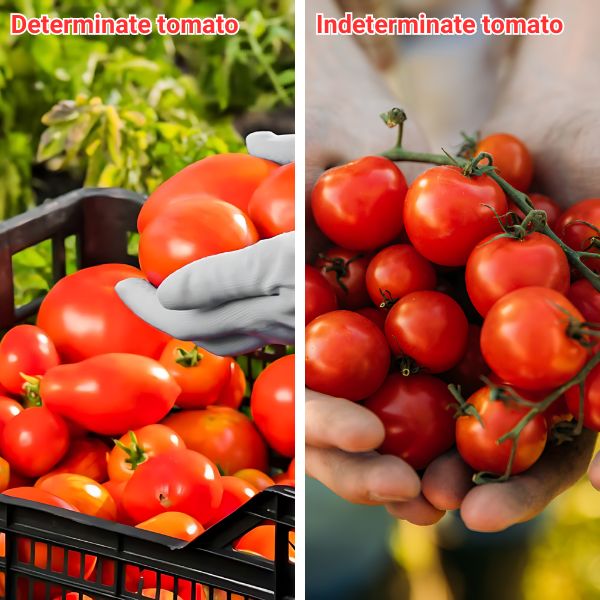
Support
Determinate tomatoes, which typically grow to about 3 to 4 feet tall, require minimal support. I often use standard tomato cages for determinate varieties. These cages are easy to install and provide enough support to keep the plants upright and the fruit off the ground.
Another option is using short stakes. You can place a stake next to each plant and tie the main stem to the stake with soft garden ties. This method works well to keep the plant supported without overwhelming its natural growth pattern.
In contrast, indeterminate tomatoes growing over 6 feet tall, require more robust and taller support structures. I use stakes that are at least 6 to 8 feet tall. I drive the stakes deep into the ground to provide stability and tie the main stem to the stake as the plant grows.
Another effective method is using trellises. I construct a trellis system with horizontal wires or strings that the plants can climb. As the plants grow, I weave the stems through the trellis, which supports their upward and outward growth.

Harvesting Techniques
Determinate tomato plants ripen all their fruit within a short period, usually about two weeks. Once the fruit ripens, harvest everything at once, as the plant will soon lose its vigor and stop producing new fruit.
Indeterminate tomatoes provide a slow and steady supply of fruit throughout the season. They take longer to start ripening but keep producing continuously.
If frost is expected, pick all the tomatoes, including the green ones, which can ripen on a sunny windowsill or in brown paper bags. This helps extend your harvest into the colder months.
Ideal Uses
Determinate tomatoes, with their compact growth and synchronized fruiting, are perfect for making sauces and canning. I love how they provide a large harvest all at once, making it easy to process and preserve in bulk.
Indeterminate tomatoes, on the other hand, are a delight for those who savor fresh, vine-ripened tomatoes throughout the season.
These tomatoes continue producing fruit steadily, making them perfect for salads, sandwiches, and daily meals. Their taste varies from sweet to slightly acidic, adding a fresh, complex flavor to dishes.
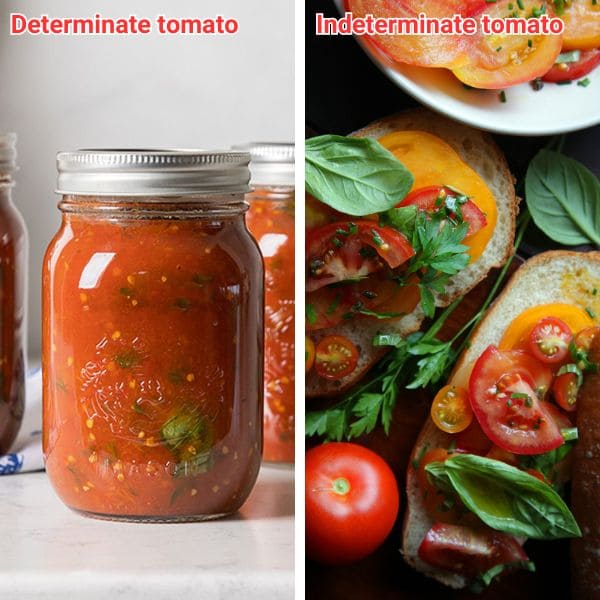
Pruning
Determinate tomatoes, with their bushy and compact growth, require minimal pruning. I find it sufficient to remove the lower leaves to improve air circulation and reduce the risk of disease.
Indeterminate tomatoes, however, benefit greatly from regular pruning. These vining plants continue to grow and produce fruit throughout the season.
I regularly prune the suckers that develop in the leaf axils to direct the plant’s energy toward fruit production. This not only helps manage their sprawling growth but also improves fruit quality and reduces the risk of disease.
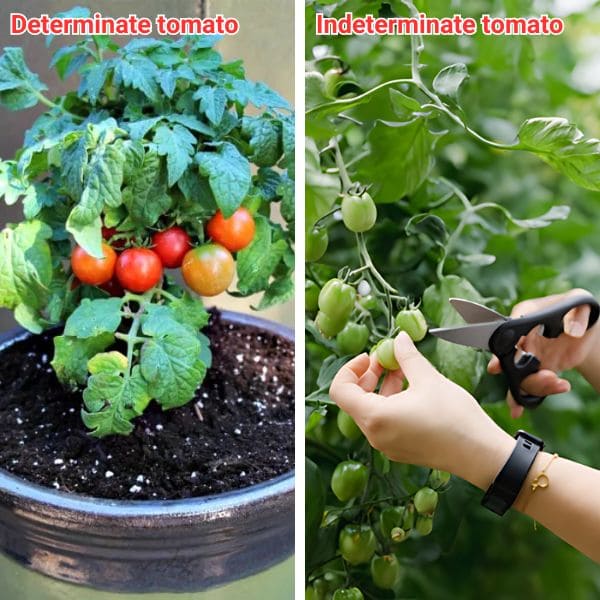
The Similarity Between Determinate Vs Indeterminate Tomatoes
Nutritional Benefits
Regardless of the variety you choose, you’ll enjoy a wealth of vitamins and minerals. Both types are rich in vitamin C, which supports immune health, and vitamin A, which is crucial for vision and skin health.
They also contain potassium, essential for heart function, and lycopene, a potent antioxidant linked to reduced cancer risk.

Growth Requirements
Both determinate and indeterminate tomatoes thrive in well-drained soil rich in organic matter. Giving them full sun, about six to eight hours a day really boosts their growth and fruit production. You also need to keep the soil evenly moist and prevent issues like blossom-end rot.
Besides, feeding them with a balanced fertilizer throughout the growing season ensures they get the nutrients needed for vigorous growth and abundant fruiting. Both types benefit from proper spacing to improve air circulation, reducing the risk of diseases.

Lifecycle
These plants are typically grown as annuals, meaning they complete their entire lifecycle-from germination to fruiting and then dying-within a single growing season.
I usually start my tomato seeds indoors about six to eight weeks before the last frost date. Once the seedlings are strong enough, I transplant them outdoors, where they grow, flower, and set fruit throughout the summer.
Pest and Disease
These tomatoes are susceptible to common tomato pests like aphids, hornworms, and whiteflies, which can damage leaves and fruit. I find regular inspection and organic pest control methods, like neem oil or introducing beneficial insects, to be effective for both varieties.
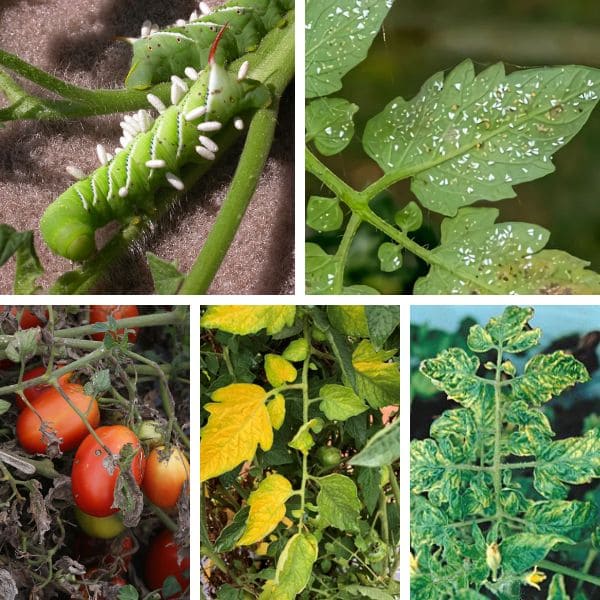
Furthermore, diseases such as blight, fusarium wilt, and mosaic virus can also affect both determinate and indeterminate tomatoes. You need to ensure good air circulation, practice crop rotation, and use disease-resistant varieties to help mitigate these issues.
Companion Planting
You can consider planting basil and marigolds alongside tomatoes. Basil not only improves tomato flavor but also repels aphids, whiteflies, and tomato hornworms. Marigolds are also excellent at keeping nematodes and other harmful insects at bay.
Additionally, planting garlic and onions nearby helps deter spider mites. Both tomato types benefit from these companions, which create a healthier garden ecosystem.
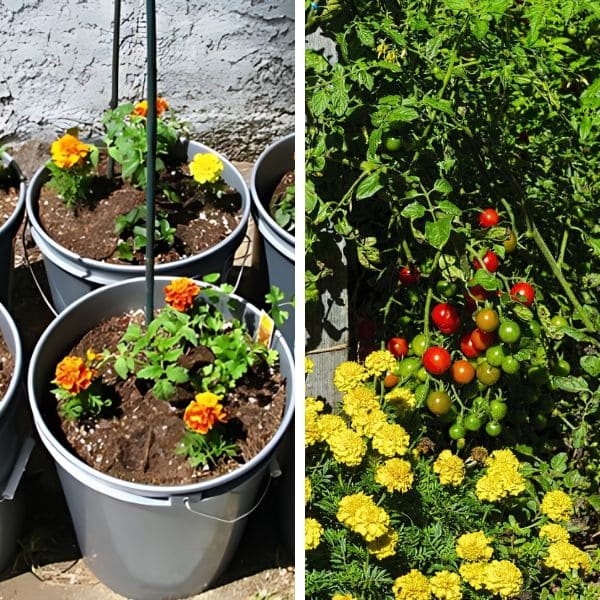
What to Choose Between Determinate Vs Indeterminate Tomatoes
Space
If you have limited space, determinate tomatoes are your best bet. They grow compact and bushy, making them ideal for small gardens or patios.
On the other hand, if you have ample space and can install sturdy supports, indeterminate tomatoes can be a rewarding choice. These vining varieties need trellises or stakes.
I love growing indeterminates in my garden for their continuous harvest, but in tighter spaces, determinates are definitely the way to go.
Harvest Timing
Determinate tomatoes are perfect if you want a large, concentrated harvest. I find this ideal for canning and making sauces, as the plants produce all their fruit within a few weeks. It’s a busy but rewarding period with plenty of tomatoes to process at once.
Indeterminate tomatoes, however, offer a different experience. They provide a steady supply of fruit throughout the growing season. If you enjoy picking fresh tomatoes regularly from summer to fall, indeterminate varieties are the way to go.
FAQs
Which is better, determinate or indeterminate tomatoes?
It depends on your gardening goals and space. Determinate tomatoes are better for those looking to can and process a large harvest at once, while indeterminate tomatoes are ideal for a continuous supply of fresh tomatoes throughout the season.
Will determinate tomatoes produce again?
No, determinate tomatoes generally do not produce new fruit after their initial harvest. Once they set and ripen all their fruit, their production decreases significantly.
Is beefsteak tomato determinate or indeterminate?
Beefsteak tomatoes are typically indeterminate. They continue to grow and produce large, juicy fruits throughout the growing season.
